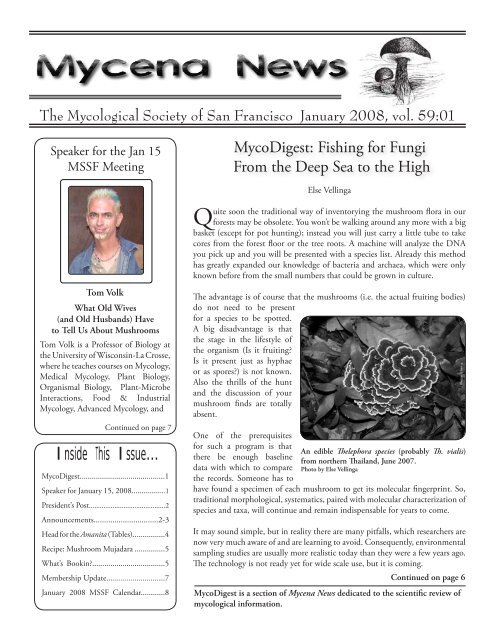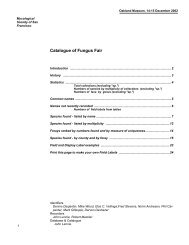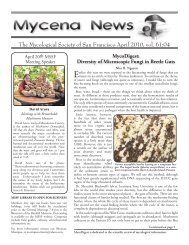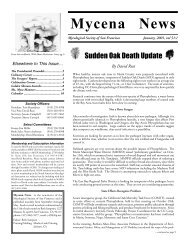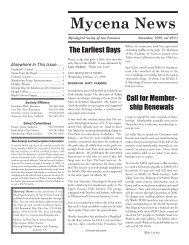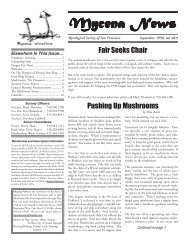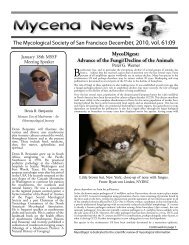January, 2008 - Mycological Society of San Francisco
January, 2008 - Mycological Society of San Francisco
January, 2008 - Mycological Society of San Francisco
Create successful ePaper yourself
Turn your PDF publications into a flip-book with our unique Google optimized e-Paper software.
The <strong>Mycological</strong> <strong>Society</strong> <strong>of</strong> <strong>San</strong> <strong>Francisco</strong> <strong>January</strong> <strong>2008</strong>, vol. 59:01<br />
Speaker for the Jan 15<br />
MSSF Meeting<br />
Tom Volk<br />
What Old Wives<br />
(and Old Husbands) Have<br />
to Tell Us About Mushrooms<br />
Tom Volk is a Pr<strong>of</strong>essor <strong>of</strong> Biology at<br />
the University <strong>of</strong> Wisconsin-La Crosse,<br />
where he teaches courses on Mycology,<br />
Medical Mycology, Plant Biology,<br />
Organismal Biology, Plant-Microbe<br />
Interactions, Food & Industrial<br />
Mycology, Advanced Mycology, and<br />
Continued on page 7<br />
Inside This Issue...<br />
MycoDigest..........................................1<br />
Speaker for <strong>January</strong> 15, <strong>2008</strong>.................1<br />
President’s Post..........................................2<br />
Announcements...............................2-3<br />
Head for the Amanita (Tables)................4<br />
Recipe: Mushroom Mujadara ...............5<br />
What’s Bookin?....................................5<br />
Membership Update.............................7<br />
<strong>January</strong> <strong>2008</strong> MSSF Calendar............8<br />
MycoDigest: Fishing for Fungi<br />
From the Deep Sea to the High<br />
Else Vellinga<br />
Quite soon the traditional way <strong>of</strong> inventorying the mushroom flora in our<br />
forests may be obsolete. You won’t be walking around any more with a big<br />
basket (except for pot hunting); instead you will just carry a little tube to take<br />
cores from the forest floor or the tree roots. A machine will analyze the DNA<br />
you pick up and you will be presented with a species list. Already this method<br />
has greatly expanded our knowledge <strong>of</strong> bacteria and archaea, which were only<br />
known before from the small numbers that could be grown in culture.<br />
The advantage is <strong>of</strong> course that the mushrooms (i.e. the actual fruiting bodies)<br />
do not need to be present<br />
for a species to be spotted.<br />
A big disadvantage is that<br />
the stage in the lifestyle <strong>of</strong><br />
the organism (Is it fruiting?<br />
Is it present just as hyphae<br />
or as spores?) is not known.<br />
Also the thrills <strong>of</strong> the hunt<br />
and the discussion <strong>of</strong> your<br />
mushroom finds are totally<br />
absent.<br />
One <strong>of</strong> the prerequisites<br />
for such a program is that<br />
there be enough baseline<br />
data with which to compare<br />
the records. Someone has to<br />
An edible Thelephora species (probably Th. vialis)<br />
from northern Thailand, June 2007.<br />
Photo by Else Vellinga<br />
have found a specimen <strong>of</strong> each mushroom to get its molecular fingerprint. So,<br />
traditional morphological, systematics, paired with molecular characterization <strong>of</strong><br />
species and taxa, will continue and remain indispensable for years to come.<br />
It may sound simple, but in reality there are many pitfalls, which researchers are<br />
now very much aware <strong>of</strong> and are learning to avoid. Consequently, environmental<br />
sampling studies are usually more realistic today than they were a few years ago.<br />
The technology is not ready yet for wide scale use, but it is coming.<br />
Continued on page 6<br />
MycoDigest is a section <strong>of</strong> Mycena News dedicated to the scientific review <strong>of</strong><br />
mycological information.
Page 2 The Mycena News, <strong>January</strong> <strong>2008</strong><br />
PRESIDENT’S POST<br />
There is nothing quite like the sound <strong>of</strong> rain to put<br />
a smile on a mushroom lover’s face, eh? Let’s hope<br />
these mid-December storms are fruitful.<br />
Are you registered on the MSSF Yahoo Groups list? It’s<br />
a terrific venue for finding out about all kinds <strong>of</strong> things<br />
“mushroom.” We <strong>of</strong>ten post important notices for members<br />
such as upcoming events, requests for volunteers,<br />
deadlines for submissions to this newsletter, etc. In addition,<br />
members like Herman, Christopher, Hugh, and others<br />
are quite generous in sharing what species are fruiting<br />
and where. (I notice they are not too specific, though.)<br />
Occasionally we’ll get reports on what’s being sold in the<br />
local markets. (The cost <strong>of</strong> which usually drives us to head<br />
for the woods!) Speaking <strong>of</strong> which, the Yahoo list is a great<br />
place to hook up with other like-minded folks. (Be sure to<br />
respond <strong>of</strong>f list!). Web watchers like Mike and Mark ply<br />
us with interesting news stories from around the world<br />
regarding fungi. If we’re really lucky we might even get a<br />
recipe from Patrick, David, or one <strong>of</strong> the other excellent<br />
chefs in the <strong>Society</strong>. There are also discussions on the finer<br />
points <strong>of</strong> mushroom identification. (Thank you, Dimitar,<br />
for sparking a little academic discourse on occasion).<br />
Not interested in that stuff? Well, the MSSF Yahoo<br />
Groups website has some other valuable features. Of particular<br />
importance is the Calendar. The MSSF leadership<br />
will endeavor to keep it up to date regarding events <strong>of</strong><br />
interest, including the general meetings, forays, culinary<br />
committee dinners, fungus fairs, etc. For example, we are<br />
planning to bring back local forays to places like Lands<br />
End in <strong>San</strong> <strong>Francisco</strong> and Joaquin Miller Park in Oakland.<br />
As Norm, our foray chair, says, “There is nothing<br />
quite as disappointing as going on a foray where there are<br />
no mushrooms.” So, we will be announcing local forays<br />
on fairly short notice in accordance with the weather. And<br />
it is easily and effectively done using the Calendar and<br />
Message postings on Yahoo Groups.<br />
Finally, I want to point out two more features available to<br />
us: Files and Photos. If you peruse the Files you will find<br />
species lists from forays and downloadable documents for<br />
teachers to use, plus videos, jpegs, and pdf files on various<br />
topics. You too can post interesting items here. Thanks<br />
to a few outstanding photodocumentarians, we have an<br />
excellent gallery <strong>of</strong> digital photographs <strong>of</strong> mushrooms and<br />
mushroomers available for your viewing pleasure. Check<br />
out the Photo section!<br />
For more information on joining MSSF Yahoo Groups<br />
see the notice on page three. Good hunting!<br />
~J.R.<br />
Announcements<br />
Fungus Fair Follow-Up Meeting<br />
Wednesday, <strong>January</strong> 30, 7pm at the Oakland Museum. Join us<br />
for a review <strong>of</strong> the 2007 Fungus Fair and <strong>of</strong>fer suggestions for the<br />
<strong>2008</strong> Fair. Please RSVP, as the date may change or be cancelled.<br />
E-mail your suggestions and/or your plans to attend to<br />
moniquecarment@yahoo.com. Thanks!<br />
Take A Chance on Truffles<br />
MSSF members inclined toward risk-taking and armchair foraging<br />
may be interested to know that a mere $300 can purchase an<br />
oak tree in France, inoculated with truffle spores. And what <strong>of</strong><br />
the precious mushrooms that might appear? Well, those would<br />
be shipped to your home, <strong>of</strong> course. For more info on this wacky<br />
scheme, check out www.truffle-tree.com. Current or future participants<br />
are encouraged to keep us posted on their luck. Thanks<br />
to David Eichorn for the tip!<br />
Mushrooms From Far-Away Lands<br />
Dear Editors,<br />
In your December<br />
issue you said<br />
“Send us your<br />
vacation story<br />
about forays in<br />
far-away lands.”<br />
Attached is a<br />
photo we took<br />
over Thanksgiving<br />
2007, on<br />
our property<br />
in South Andros,<br />
Bahamas.<br />
These beautiful,<br />
leather-tough,<br />
striated-mahogony-colored,<br />
9”<br />
diameter mushrooms<br />
are growing<br />
in the sandy<br />
duff under the coconut<br />
palms, by a dead poisonwood (Metopium browneii) tree<br />
stump, amid dead leaves from surrounding gumbolimbo (aka<br />
kamalamee) trees. We have no field guide for Bahamian mushrooms<br />
and no clue what they are. The mushroom caps had a few<br />
leaf parts deeply embedded in them, which the mushrooms had<br />
grown up around.<br />
- Laura Roden, MSSF member<br />
See www.mssf.org for a color image. Photo by<br />
Laura Roden<br />
Send your tales <strong>of</strong> mushrooms from far-away lands to<br />
mycenanews@mssf.org
The Mycena News, <strong>January</strong> <strong>2008</strong><br />
New MSSF Calendar on Yahoo Group<br />
The calendar function on the MSSF Yahoo Group is now active. To access this<br />
growing locus <strong>of</strong> exciting information, simply log-in to the MSSF Yahoo Group<br />
and click on the calendar link on the left-hand side <strong>of</strong> the page. Our goal is to<br />
use this calendar for scheduling impromptu events that can not be included the<br />
monthly calendar cycle <strong>of</strong> the Mycena News. This is a great way for MSSF members<br />
to find partners for last-minute trips! To join the YahooGroup:<br />
- Go the MSSF web site at www.mssf.org, and click the “Members Only!” link.<br />
- Enter the name “mssf” and the password “smithii.”<br />
- Click the link “Join the MSSF mailing list!”<br />
- Follow the YahooGroups instructions for subscribing.<br />
A few tips:<br />
- Subscribe using an e-mail address that we have in the MSSF roster. (If you paid<br />
through PayPal, that’s the e-mail address you used to pay with.)<br />
- Don’t forget to respond with your name and address, which is<br />
especially important if your e-mail address doesn’t match an address<br />
in the MSSF roster.<br />
- Once you’ve subscribed, you can maintain your subscription in the<br />
YahooGroups MSSF list page, where you can change your e-mail address,<br />
set delivery mode, and perform other tasks.<br />
- Don’t forget to notify the membership chair if you change e-mail<br />
addresses, so we’ll recognize your address and keep you on when we<br />
perform the annual removal <strong>of</strong> unpaid members from the list.<br />
Marin Mushroom Mania—February 9, <strong>2008</strong><br />
***Volunteer Coordinator Needed***<br />
Volunteers needed to foray and staff tables<br />
(Benefits: free dinner Friday night/free lunch Saturday/no admission fee)<br />
Contact Terri Beausejour at terri.beausejour@autodesk.com<br />
$25 entry includes:<br />
Speakers:<br />
Ken Litchfield - The Intrigue <strong>of</strong> Fungi<br />
David Campbell - Fungimental Mycophagy…<br />
Dorothy Beebee - Mushrooms for Color<br />
Taylor F. Lockwood - Chasing the Rain<br />
Dr. Dennis Desjardin - Bioluminescent Fungi Around the World<br />
Workshops:<br />
Cultivation - Log plugging demo and take home your own pet log<br />
Mushroom Taxonomy - Hands-on Characteristics and Distinctions<br />
Mushrooms for Color - Hands on dying with mushrooms<br />
Cooking Demos - Several cooking demos during the lunchtime break<br />
Deadline for the February <strong>2008</strong> issue <strong>of</strong> Mycena News is<br />
<strong>January</strong> 15.<br />
Please send your articles, calendar items, and other information to<br />
mycenanews@mssf.org<br />
<strong>January</strong> <strong>2008</strong>, vol. 59:01<br />
Page 3<br />
Contributors:<br />
Terri Beausejour, J.R. Blair,<br />
Monique Carment, Alvaro<br />
Carvajal, Cordelia Chadwick,<br />
Pat George, Curt Haney, Laura<br />
Roden, Henry Shaw, Barbara and<br />
Bob Sommer, Else Vellinga<br />
Editing and Layout:<br />
Cordelia Chadwick, Jeffrey Fisher<br />
Mycena News is the member’s<br />
newsletter <strong>of</strong> the <strong>Mycological</strong><br />
<strong>Society</strong> <strong>of</strong> <strong>San</strong> <strong>Francisco</strong>, and<br />
is published monthly from<br />
September through May.<br />
Please e-mail photos, comments,<br />
corrections, and correspondence<br />
to mycenanews@mssf.org.<br />
To subscribe, renew, or make<br />
address changes, please contact<br />
Alvaro Carvajal: alvaro.carvajal@<br />
sbcglobal.net / (415) 695-0466.<br />
Past issues <strong>of</strong> Mycena News can be<br />
read on-line at www.mssf.org.<br />
MSSF Officers 2007-<strong>2008</strong><br />
President: J.R. Blair<br />
(650) 728-9405<br />
jrblair@mssf.org<br />
Vice President: Dan Long<br />
(925) 945-6477<br />
danlong@astound.net<br />
Secretary: Phil Brown<br />
(510) 526-4325<br />
towltek2000@msn.com<br />
Treasurer: Lisa Bacon<br />
(707) 765-9085<br />
lisa.bacon@comcast.net
Page 4 The Mycena News, <strong>January</strong> <strong>2008</strong><br />
Working the displays at the annual Fungus Fair is a great<br />
way to meet the public and generate interest in fungi.<br />
Each table contains several genera neatly arranged in duff and<br />
with ID tags (a description that fits us, as well). Before we arrive,<br />
we have no idea which tables we will handle. That motivates us<br />
to arrive early—the early docents get the interesting tables. “Interesting”<br />
in this context refers to distinctive features likely to<br />
intrigue the public. These can be physical appearance, edibility,<br />
toxicity, psychoactivity, and any unusual qualities such as<br />
bruising, staining, or a distinctive odor. A physical demonstration<br />
<strong>of</strong> an interesting property is more appealing than physical<br />
appearance by itself.<br />
The choice table for a docent contains<br />
the Amanitas which are big, beautiful,<br />
and in some cases, lethal. They have distinctive<br />
features such as rings, patches,<br />
and a volva. We have a standard patter<br />
for Nitas, how a few like the grisette and<br />
cocorra (the Italian Grandmother story)<br />
are edible, but too dangerous for beginners<br />
to collect, while others will kill you<br />
(famous poisonings). There are always<br />
good muscaria stories as everyone has<br />
seen it on book covers and posters. The<br />
boletes are big, beautiful, and buggy. By<br />
afternoon on the last day <strong>of</strong> the Fair,<br />
there is no worse assignment. This is<br />
material for an entomology lecture.<br />
Following our prepared battle plan, we<br />
arrived early for docent duties and made<br />
a beeline for the Amanita table. Within<br />
minutes, another volunteer asked to<br />
trade places. She ended up behind the<br />
display <strong>of</strong> Inocybe, Corts, and Pholiota. Dull, dull, dull. For<br />
some reason, the brown-spored fungi don’t <strong>of</strong>fer much in the<br />
way <strong>of</strong> public interest. Bob felt sorry for her and traded tables<br />
midway through the shift. His spiel at the Amanita table was<br />
becoming repetitious. He also tired <strong>of</strong> explaining that the shiny<br />
chestnut-colored Buckeye seeds, inserted in the display as a<br />
habitat marker, were not mushrooms.<br />
Head for the Amanita (Tables)<br />
Barbara and Bob Sommer<br />
Specimen tables at the 2007 Annual Fungus<br />
Fair. Photo by Henry Shaw<br />
disappeared when a local <strong>of</strong>ficial with a bigger name tag than<br />
ours removed the smut to the puffball section.<br />
Some genera can be good or bad for docents depending on<br />
which species have been collected. Russulas with distinctive<br />
odors include the xerampelina (fishy), fragrantissima (fragrant),<br />
and the over-the-hill blackened subnigricans (fetid, unpleasant).<br />
If you don’t have these species, the Russula table is a loser. You<br />
can demonstrate the tendency <strong>of</strong> Russulas to break cleanly with<br />
a cracking sound, but this depletes the displays. One docent<br />
said she liked to hurl them at the wall to show how they shattered<br />
(she controlled herself).<br />
The Lactarius table is good until late<br />
afternoon when tired specimens, exhausted<br />
from hours <strong>of</strong> performing,<br />
are depleted <strong>of</strong> latex. The public will<br />
marvel at different colored droplets<br />
and staining reactions (always good<br />
to have rubrilacteus available). But<br />
lactarius can be a one-trick pony. Besides<br />
the latex, there is not much else<br />
to demonstrate, and it is boring to repeat<br />
the litany that delicious isn’t.<br />
The Fair runs two days, and by Sunday—despite<br />
frequent spraying—distinctive<br />
qualities diminish and the<br />
ink on hand-written IDs runs. Experienced<br />
docents acknowledge that<br />
“the second day is tough.” By Sunday<br />
afternoon, the muscaria is no longer<br />
scarlet, the chanterelle has lost<br />
its golden luster, and the Lactarius<br />
is almost as dry as an old Leucopax.<br />
Several mushrooms, caps completely eaten out by bugs, have<br />
collapsed in a smelly mess, and tiny fungi have shriveled to<br />
nothing. Fungi growing on fungi add to the earthy smell at the<br />
tables. The most scary, albeit instructive, observation was the<br />
physical resemblance between a faded cocorra (its cap dingy<br />
yellow-brown, meringue retracted into patches) and a faded<br />
death cap.<br />
In the event one <strong>of</strong> us ended up with blah mushrooms, we<br />
brought a prop. The previous day we had purchased fresh corn<br />
from an organic grower at the farmers market. Shucking the<br />
ears, we discovered corn smut—<strong>of</strong>fered on menus <strong>of</strong> upscale<br />
restaurants as huitlachoche or “corn truffle” (a delicacy in Mexico).<br />
The appearance <strong>of</strong> blue-gray mushrooms sprouting from<br />
an ear <strong>of</strong> corn was sure bait for visitor questions. Our prop<br />
Outside light started fading after 3pm, further reducing the<br />
visual appeal <strong>of</strong> fungi. Fortunately, first-time visitors don’t see<br />
these things. They are still amazed by the reddish muscaria,<br />
wide-eyed at the variety <strong>of</strong> coral shapes and colors, admiring <strong>of</strong><br />
the still graceful but faded beauty <strong>of</strong> the chanterelle, and take<br />
on faith that a fresh Lactarius yields latex.<br />
Continued on page 6
The Mycena News, <strong>January</strong> <strong>2008</strong><br />
A Vegetarian Recipe for Winter<br />
Cordelia Chadwick<br />
The following is a hearty and easy winter meal suggestion,<br />
and a healthy way to kick start ’08:<br />
Mushrooms over Mujadara<br />
Ingredients (serves 4–6):<br />
- 4 to 6 portabella mushrooms (or any wild equivalent and<br />
quantity <strong>of</strong> your choice)<br />
- 1 large bunch Swiss chard<br />
- 3 medium to large size red beets<br />
- 1 bulb Gilroy garlic, peeled and finely chopped<br />
- 1 cup brown rice (California grown or fair trade sourced)<br />
- 1 cup lentils (washed)<br />
- 1 large yellow onion (or 2 normal-sized), sliced<br />
- 4 pods cardamom, freshly ground (sans outer pod)<br />
- lots <strong>of</strong> chili powder<br />
- olive oil (if you prefer, substitute with ghee or fresh butter)<br />
- vinegar <strong>of</strong> your choice<br />
- herbs you enjoy with your mushrooms<br />
- salt & pepper<br />
- 3 cups water (plus more for steaming chard)<br />
- sugar to taste, if you opt for beet relish<br />
Beet relish/salsa/purée: Clean and put beets in oven for<br />
roasting. (Rub with olive oil, pepper, and any other spice you<br />
like!). Remove once sufficiently rubied, then chop and add to<br />
a saucepan containing heated vinegar and sugar. Cook until<br />
desired consistency and flavor develop. You can also make a<br />
beet salsa or purée for garnish: chop beets and add cilantro,<br />
lime juice, and chopped onion; or finely chop then whir in<br />
your food processor alone or with any flavor combination you<br />
prefer (e.g. yogurt, wasabi, figs, port). Comme vous voulez,<br />
Chef!<br />
Mujadara: Add approximately 1/4 cup olive oil to a saucepan<br />
(with a matching lid), heat, add lots <strong>of</strong> chili powder, a teeny<br />
pinch <strong>of</strong> salt, cracked pepper, and sliced onions. Caramelize<br />
the onions, then add approximately half the chopped garlic<br />
and all the freshly ground cardamom. Stir vigorously, then<br />
add dry brown rice and lentils. Continue to stir until all lentils<br />
and rice are coated with onions and spice, then add 3 cups<br />
water and bring to boil. Cover, bring to a gentle simmer, and<br />
let cook approximately 40 minutes. I like my rice and lentils<br />
al dente, but if you prefer something a little s<strong>of</strong>ter, add more<br />
water or adjust cook time to your palate.<br />
Chard: Clean and chop the chard, then steam or saute chard<br />
in olive oil, and lightly toss in vinegar.<br />
Mushrooms: Dust <strong>of</strong>f dirt and perform your typical mushroom<br />
preparation rites/worship. Saute in olive oil, herbs, and<br />
the rest <strong>of</strong> the garlic. Pour some red wine into the skillet, if<br />
you like. Keep warm in oven at about 250 Fahrenheit...<br />
What’s Bookin?<br />
Page 5<br />
Curt Haney<br />
Mushrooms for Dyes, Paper, Pigments<br />
& Myco-Stix, by Miriam C. Rice and<br />
illustrated by Dorothy M. Beebee.<br />
Miriam C. Rice became the first<br />
person in the world to quantify and<br />
publish the results <strong>of</strong> experiments<br />
with fungi-producing dyes in 1974’s<br />
Let’s Try Mushrooms for Color. An expanded<br />
version, Mushrooms for Color,<br />
followed in 1980, and both books were illustrated by Beebee.<br />
(Both <strong>of</strong> these books are now out <strong>of</strong> print.)<br />
With this third book, Rice and Beebee detail the history, development,<br />
and science <strong>of</strong> mushroom arts. It both tells and shows<br />
how to extract substances from mushrooms that allow an artist<br />
to make textile dyes, paper sculpture, plain paper, watercolors,<br />
and crayons for drawing. Beebee’s pen and ink drawings appear<br />
throughout the book, and color photos <strong>of</strong> mushroom arts accompany<br />
each section.<br />
Miriam has devised a way to turn mushroom-extracted pigments<br />
into drawing tools, the result being her invention and development<br />
<strong>of</strong> “Myco-Stix.” This book introduces this new drawing<br />
tool to artists everywhere.<br />
This new book will be available at the <strong>January</strong> <strong>2008</strong> MSSF General<br />
Meeting. List Price: $32.95 plus tax (MSSF members receive<br />
a 10% discount.)<br />
Putting it all together: Spoon delightfully fragrant mujadara<br />
onto individual plates, add mushroom, then garnish with generous<br />
heaps <strong>of</strong> beets and chard. Bon apetit! •<br />
Do you have a favorite recipe? Or perhaps cooking tips you’d like<br />
to share with MSSF members? Please send your ideas, recipes,<br />
and pictures to mycenanews@mssf.org
Page 6 The Mycena News, <strong>January</strong> <strong>2008</strong><br />
MycoDigest continued from page 1<br />
The same approach can be used to fish for fungi in the sea. You<br />
take seawater, filter it to get the organisms, extract DNA, and<br />
with a specific “bait” (in fact, a short piece <strong>of</strong> complementary<br />
DNA) you can fish the fungi out, or at least the sequences<br />
that serve as their ID-tags. There are particular tags that will<br />
distinguish fungi from other organisms, though <strong>of</strong> course you<br />
won’t know their species or even, perhaps, be able to say much<br />
about who their fungal relatives are.<br />
(widespread here in the Bay Area) and Pneumocystis carinii,<br />
the cause <strong>of</strong> pneumonia—especially in people whose immune<br />
system is compromised. The Saccharomycotina is the group<br />
<strong>of</strong> the budding yeasts, including Baker’s and Brewer’s yeasts.<br />
The one other asco-subphylum known is the Pezizomycotina;<br />
it contains morels, most lichens, cup fungi, etc., and is more<br />
derived than the others. The newly discovered subphylum<br />
is prosaically and provisionally called Soil Clone Group I or<br />
“SCGI.” A proper name awaits characterization <strong>of</strong> its features.<br />
What about fishing with really long lines? From time to time<br />
National Geographic shows pictures <strong>of</strong> the most amazing<br />
and fantastic animals from the depth <strong>of</strong> the oceans—so what<br />
about the fungi? Alas, as yet no one has seen spectacular fungal<br />
forms in the oceanic abyss, but a few representatives in a small<br />
number <strong>of</strong> species have been found. Most are yeasts, in the<br />
ascomycetes (like such things as Brewer’s and Baker’s yeasts)<br />
or in the basidiomycetes (some are close to the basidio-yeast<br />
Cryptococcus ne<strong>of</strong>ormans, a ubiquitous species). An earlier study,<br />
showing that Baker’s yeast can survive short periods <strong>of</strong> high<br />
hydrostatic pressure, such as what prevails deep in the ocean,<br />
makes this all the more plausible. Several <strong>of</strong> the recovered fungi<br />
might be parasites <strong>of</strong> deep-sea animals. From the species found<br />
at different depths, it looks plausible that there is occasional<br />
contact between the different sea layers, and that fungi living<br />
in shallow waters, or even on land, may occasionally end up in<br />
the depths.<br />
On land, we thought that we had a rather good idea about the<br />
different fungi. We have been looking for a long time and have<br />
done much direct sampling; have observed fungi as pathogens<br />
on plants, animals and people; and have grown them on<br />
cultures. It came as a big surprise when a completely new type<br />
<strong>of</strong> ascomycetes was discovered in soil in the Colorado Rockies<br />
a few years ago. This new group did not just represent a species<br />
in the midst <strong>of</strong> well-known relatives—the morels, say—but a<br />
basal branch on the ascomycete tree.<br />
It seems that several researchers, without realizing the<br />
significance, had already uncovered some evidence <strong>of</strong> these<br />
new fungi. With further sampling from Canada to Costa Rica,<br />
at treeline in the high mountains to tropical lowland forests,<br />
a tentative concept <strong>of</strong> this still nameless group has emerged.<br />
At the high altitude sites, they have only been found during<br />
the summer, never under the snow. At least 30 species have<br />
been discovered already, most <strong>of</strong> them in living roots <strong>of</strong> trees<br />
and grasses. Nobody has actually seen one <strong>of</strong> these fungi yet,<br />
but their place in the grander scheme <strong>of</strong> the ascomycetes has<br />
become clearer.<br />
We know that they make up a new group, probably at the<br />
level <strong>of</strong> subphylum, within the ascomycetes, and fit between<br />
the Taphrinomycotina and the Saccharomycotina. The<br />
Taphrinomycotina harbor the peach leaf curl disease Taphrina<br />
Although it is <strong>of</strong>ten supposed that the biggest diversity <strong>of</strong> fungi<br />
not yet described lurks inside plants, this research shows that<br />
new fungi may be present under our noses in places we thought<br />
we had explored thoroughly. All these unknown soil and marine<br />
fungi are recognized solely on account <strong>of</strong> their DNA; what they<br />
look like is still a big mystery! •<br />
Further reading:<br />
Bass, D., A. Howe, N. Brown, H. Barton, M. Demidova, H.<br />
Michelle, L. Li, H. <strong>San</strong>ders, S.C. Watkinson, S. Willcock &<br />
T.A. Richards, 2007. Yeast forms dominate fungal diversity in<br />
the deep oceans. Proc. Royal Soc. B 274: 3069-3077.<br />
Porter, T.M., C.W. Schadt, L. Rizvi, A.P. Martin, S.K.<br />
Schmidt, L. Scott-Denton, R. Vilgalys & J.M. Moncalvo,<br />
2007. Widespread occurrence and phylogenetic placement <strong>of</strong> a<br />
soil clone group adds a prominent new branch to the fungal<br />
tree <strong>of</strong> life. Mol. phylogenetics Evolution. doi:10.1016/<br />
j.ympev.2007.10.002.<br />
Schadt, C.W., A.P. Martin, D.A. Lipson & S.K. Schmidt,<br />
2003. Seasonal dynamics <strong>of</strong> previously unknown fungal lineages<br />
in tundra soils. Science 301: 1359-1361.<br />
Amanitas Continued from page 4<br />
Every year at the Fair is different. This was a dry fall, and many<br />
familiar species were absent—no A. ocreata with which to<br />
frighten folks. Serving as a docent is fun, challenging, and a<br />
useful public service. The interactions are illuminating. We’ve<br />
learned that matsutakes smell different to different folks. For<br />
some it is the usual red-hots and dirty socks. Others report candied<br />
cherries or marzipan. Some hardly smell it at all. Several<br />
knew that jack-o’-lanterns glow in the dark, but on discussion<br />
we all confessed that we had never seen it. One attendee vowed<br />
she would not eat anything with white gills. There was a long<br />
discussion with a knowledgeable fellow about the benefits <strong>of</strong><br />
drying—improves boletes, but not matsutakes, he insisted. We<br />
courted another who lives on a large plot in the Sierra foothills—an<br />
area greatly lacking in public access. “Wouldn’t you<br />
like to join our Davis club?” Our 10-year-old grandson was<br />
very excited and went home to Alameda to find numerous fungi<br />
tucked away on his island. Maybe some day we’ll be able to<br />
make the brown-spored display interesting. •
The Mycena News, <strong>January</strong> <strong>2008</strong><br />
Time’s Running Out!<br />
Unless we receive your <strong>2008</strong> renewal before <strong>January</strong> 15, you will<br />
no longer receive the Mycena News nor will you have access to<br />
the “members only” section <strong>of</strong> the MSSF website and MSSF list<br />
server!<br />
Check your mailing label to see if you need to renew. E-Members<br />
need to check the “Membership Status” document located<br />
on the member’s only section <strong>of</strong> the MSSF web site.<br />
Members who are uncertain if they have renewed, or whether<br />
their correct e-mail address is in the database, should e-mail Alvaro<br />
Carvajal at membership@mssf.org.<br />
E-members: Remember, you must renew your membership<br />
for <strong>2008</strong> AND have your current e-mail address in the MSSF<br />
membership database if you are to receive notice <strong>of</strong> the password<br />
change that will take place in late <strong>January</strong>.<br />
You can renew on the MSSF website or by filling out the form<br />
on this page and mailing it, accompanied by Credit Card information<br />
or a check made out to “MSSF Membership,” to:<br />
MSSF Membership, c/o The Randall Museum, 199 Museum<br />
Way, <strong>San</strong> <strong>Francisco</strong>, CA, 94114-1429<br />
Want to avoid worrying about future renewals? Consider a lifetime<br />
or multiple-year renewal:<br />
Type 1-yr 2-yr 3-yr 5-yr Life<br />
Regular $25 $50 $71.25 $112.50 $500<br />
Senior(65+) $20 $40 $57.00 $90.00 $400<br />
Student $20 $40 $57.00 $90.00 n/a<br />
Electronic $15 $30 $42.75 $67.50 $300<br />
Regular members, seniors, and full-time students receive the<br />
Membership Roster and the Mycena News by mail. Electronic<br />
members must download the yearly Roster and the Mycena News<br />
from the MSSF website.<br />
To those who have renewed already, we wish you a Happy New<br />
Year and successful foraging!<br />
Speaker continued from page 1<br />
Latin & Greek for Scientists. His internet web page,<br />
Tom Volk’s Fungi http://TomVolkFungi.net, has a<br />
popular “Fungus <strong>of</strong> the Month” feature, and an extensive<br />
introduction to the Kingdom Fungi. Besides dabbling<br />
in mushroom cultivation, Tom has worked on the genera<br />
Morchella (morels), Hydnellum (a tooth fungus), Armillaria<br />
(honey mushrooms), and Laetiporus (chicken <strong>of</strong> the woods<br />
or sulfur shelf), as well as several medical mycology projects.<br />
He also has conducted fungal biodiversity studies in<br />
Wisconsin, Minnesota, Alaska, and Israel. He is a popular<br />
speaker at many amateur and pr<strong>of</strong>essional mycological<br />
events throughout North America, including many NAMA<br />
and NEMF forays.<br />
MYCOLOGICAL SOCIETY OF SAN FRANCISCO - Membership and Membership Renewal Application<br />
New Members: please fill out as much information as you can. Members who are renewing need to fill out only the blanks for which<br />
information has changed within the last year. Please check the current Roster to see if any <strong>of</strong> your address, phone, and e-mail need updating!<br />
Name 1:_______________________ Home Phone: _________________________________________________________________<br />
Name 2:______________________ Business Phone: ________________________________________________________________<br />
Street/Apt#/PO:______________________ Cell Phone:______________________________________________________________<br />
City:____________________ E-mail 1:___________________________________________________________________________<br />
State:____________________ E-mail 2:___________________________________________________________________________<br />
Zip Code:____________________ Interests:________________________________________________________________________<br />
New Membership?_____ Renewal?_____<br />
Membership type: ____Adult/Family ($25) ____ Senior/Students ($20) ____ Electronic ($15)<br />
If sending a check, please make it out to “MSSF membership” and mail it, with this form to: MSSF Membership, c/o The Randall Junior<br />
Museum, 199 Museum Way, <strong>San</strong> <strong>Francisco</strong>, CA 94114<br />
If paying by Credit Card, please provide the following information:<br />
Circle Type <strong>of</strong> Credit Card: MasterCard, Visa, Discovery, or American Express<br />
Credit Card Number: _______________________ Expiration Date: _______________________<br />
Page 7
<strong>Mycological</strong> <strong>Society</strong> <strong>of</strong> <strong>San</strong> <strong>Francisco</strong><br />
c/o The Randall Museum<br />
199 Museum Way<br />
<strong>San</strong> <strong>Francisco</strong>, CA 94114<br />
First Class Mail<br />
U.S. Postage<br />
PAID<br />
Oakland, CA<br />
Permit No. 1451<br />
<strong>January</strong> <strong>2008</strong>, vol. 59:01<br />
MSSF Calendar, <strong>January</strong> <strong>2008</strong><br />
Monday, <strong>January</strong> 7, <strong>2008</strong>, 7pm, Culinary Group Dinner. As<br />
usual, we will meet at the Hall <strong>of</strong> Flowers, Golden Gate Park,<br />
9th and Lincoln, SF. Dinner cost will be $14. Goat roasted<br />
in the caja china will be featured. Reservations are required.<br />
Contact Pat George at (510) 204-9130 / plgeorge33@yahoo.<br />
com no later than Friday, <strong>January</strong> 4, to make your reservation.<br />
As the Hall <strong>of</strong> Flowers does not provide tableware, you must<br />
bring your own, as well as your beverage and an appetizer to<br />
share. Our next dinner meeting will be February 4.<br />
Tuesday, <strong>January</strong> 15, <strong>2008</strong>. MSSF General Meeting. Randall<br />
Museum. 7pm, mushroom identification and refreshments<br />
provided by the Hospitality Committee. 8pm, Tom Volk will<br />
present What Old Wives (and Old Husbands) Have to Tell<br />
Us About Mushrooms.<br />
<strong>January</strong> 17, <strong>2008</strong>, 7:30pm, Beginners Mushroom<br />
Identification Workshop. Held at the Randall Museum and<br />
led by J.R. Blair. Learn key features used to identify mushrooms<br />
in standard field guides and keys. Bring your recently collected<br />
specimens and field guides.<br />
<strong>January</strong> 19–21, <strong>2008</strong>, 11th Annual SOMA Wild Mushroom<br />
Camp, Occidental, CA. SOMA Winter Mushroom Camp.<br />
Held in Occidental, CA with Tom Volk and Else Vellinga.<br />
Forays, classes, presentations, and mushroom cuisine. Fees:<br />
$275 for full weekend, $215 with <strong>of</strong>f-site lodging, $125<br />
for Sunday only. Info: 707-773-1011 / SOMAcampinfo@<br />
SOMAmushrooms.org.<br />
Saturday, <strong>January</strong> 26, <strong>2008</strong>, 7pm, Exotic Mushroom Pizza<br />
Dinner and Show at the Belrose Theatre. Sven Revel and<br />
Mauro’s Pizza and Pasta will delight you with exotic mushroom<br />
pizzas while Bay Area gothic-rock-blues band “Nightsage” will<br />
entertain you with a diverse mix <strong>of</strong> music and theatrics based<br />
on LeeriX, Nightsage’s book <strong>of</strong> lyrical poetry, and a sneakpeek<br />
at some new material featuring mysterious mycological<br />
themes. Dinner and show, $22/person (incl. a variety <strong>of</strong> pizzas,<br />
salad, and dessert). Wine and beer available for purchase. For<br />
reservations, contact The Belrose Theatre at (415) 454-6422,<br />
http://www.thebelrose.com, 1415 5th Ave, <strong>San</strong> Rafael, CA.<br />
Wednesday, <strong>January</strong> 30, 7pm Fungus Fair Follow Up<br />
Meeting. Join us at the Oakland Museum for a review <strong>of</strong> the<br />
2007 Fair and <strong>of</strong>fer suggestions for the <strong>2008</strong> Fair. Please RSVP,<br />
as the date may change. E-mail your suggestions and/or your<br />
plans to attend to moniquecarment@yahoo.com<br />
February 9, Marin Mushroom Mania Marin Art and Garden<br />
Center. See page 3 for full details.


